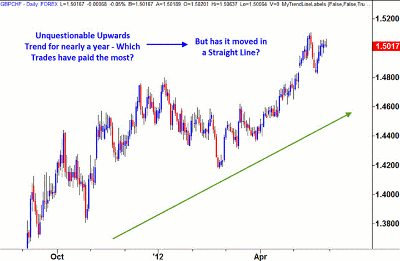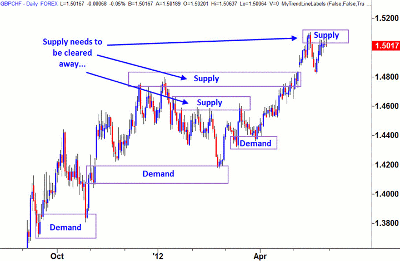The old trading adage "The trend is your friend" isn't entirely true, especially in forex, where trends don't move in straight lines, explains Sam Evans, instructor for Online Trading Academy.
I don't see myself as a controversial individual, yet surprisingly enough I have been regarded as such on numerous occasions by people who have asked my opinion on the markets. You see, I speak to many people every week who have a healthy interest in the markets, and they are usually looking to increase their skills in trading, hoping to finally become consistent and make money on a regular basis.
In fact, for some, I think they just want to stop losing so much. Motivations are different for everyone, yet one thing I have noticed in my years of teaching and trading is that no matter when someone started, or what their journey has entailed, for most novice market speculators, the experiences that they have had are mostly the same on the whole. You can do a search on the Internet for "trading strategies" and it is overwhelming how many hits you receive!
Now knowing that the vast majority of people in the FX markets today (retail speculators) are losing money or just breaking even in their daily trading activities, we need to ask ourselves why that is if we hope to avoid the same outcome personally.
It would seem at face value that trading profitably is practically impossible because so many people seem to fail, but this is completely the wrong way to look at it. Considering that all of the information available on the Internet is freely available to anyone at anytime for absolutely no financial cost whatsoever, is it really surprising that most people take the free education option and then run into problems?
One of the most impactful statements I ever heard was by none other than my friend and mentor Sam Seiden, who said, "If trading books had all the answers, then every librarian in the world should be a millionaire trader by now." The equation is simple in nature: if you do what everyone else does (uses the free trading education available to us all), then you have to expect to get what everyone else gets (a lack of consistency and profits from trading).
More from Sam Seiden: How to Join the 10% Who Succeed
My reason for sharing this reality with you is in direct reference to what I said in my opening paragraph of this article. Time and time again, I am seen as being controversial in my opinions on trading because what I say, do, and teach is typically not what the vast majority of people have heard or read before. Now, I also have met people who find my teachings and those of Online Trading Academy to be exactly what they needed to hear, and as such, they embrace it to its fullest extent. It is great when this happens, but like I said before, most people have to take a little time to digest the ideas at first, as they are not what they have likely heard or seen before, and this I completely understand.
One item that always comes up when I am presenting or teaching trading is the topic of trend. I would go as far as to say that this area is where I am also deemed to be the most controversial as well, although I promise you that is not my intention. If you ask people who are on their trading journey about trend, they will likely say things along the following lines:
- "Don't fight the trend.go with the trend"
- "The trend is your friend"
- "The big money is made when you trade the trend"
- "Countertrend trading is the most dangerous way to trade"
Are any of these ideas and statements familiar to you? They were some of the things I first read about when I got into trading myself and then realized that I also needed to be more open minded.
NEXT: Forex Trend-Trading Rules That Work Better
|pagebreak|As you may have read in my past articles, I like to follow a very simple, rule-based approach to trading that is based on the most important deciding factor in price changes throughout: I respect that prices must rise when demand is greater than supply and that prices must fall when supply is greater than demand. It is very hard to make money buying into areas of supply and selling into areas of demand.
See also: It All Starts with Supply and Demand
The lowest-risk way to trade will always be when you have the chance to buy before everyone else and sell before everyone else. This also offers you the very best potential rewards as well. Sure, sometimes you will lose and other times you will win, but you always need to give yourself the best possible chance for success in your strategy, because let's face it, none of us really know what's coming next.
So how does this relate to trend? Take a look at the chart below:
The above chart is a daily representation of the GBP/CHF currency pair. For almost a year now, the pair has been following a clear upward trend in price. This tells us that demand is greater than supply for the British pound over the Swiss franc.
For the buyers of this market, the trend has most definitely been their friend, but does this mean that we should just buy this market without a second thought? Do markets just move in straight lines? Clearly not, and if we would have adopted this approach, we would have faced some potentially nasty losses. Obviously, the lows have held in the long run, but not without some solid supply putting in downward pressure from time to time.
Because my strategy involves buying low at areas of demand and selling high at areas of supply, it is often misinterpreted that I am a countertrend trader. When markets fall into levels of demand, they are in downward trends at the time, and when they rally into supply, they are seen to be in upward trends, so it will always seem that a countertrend trade is being taken. However, the reality is that even if there is a prevailing trend in action at any time, my job as a trader is to look at what the best low-risk, high-reward trade is now.
Following my rules, I will never buy into supply or sell into demand. This allows me to always take trades that offer solid risk/reward ratios. Instead, I look for the best set-up that offers me the greatest objective odds stacked in my favor.
Look to the example below:
By doing this, the trend will always take care of itself, as we can see in the same daily chart of the GBP/CHF. The demand levels clearly held stronger and gave much better overall risk/reward, but we cannot ignore that fact that the supply level in this upward trend did produce reactions in price, albeit with smaller moves to the downside.
This can be expected in an upward trend, and if we are not long on the approach to the supply zones, we can use this for short-term shorts. If we were long going into these zones, then we must look to take profits at these supply areas and prepare for a correction.
In any form of trading, it is simple to recognize that trend is nothing more than a movement of price between levels of supply and demand. I am not a countertrend trader in any way, shape, or form. In fact, I would class myself as the consummate trend trader: I look to get into the trend if there is still room for it to run, and if not, then I will look to buy or sell my way into the next big trend that I anticipate. There's nothing too controversial about that.
By Sam Evans, instructor, Online Trading Academy






















